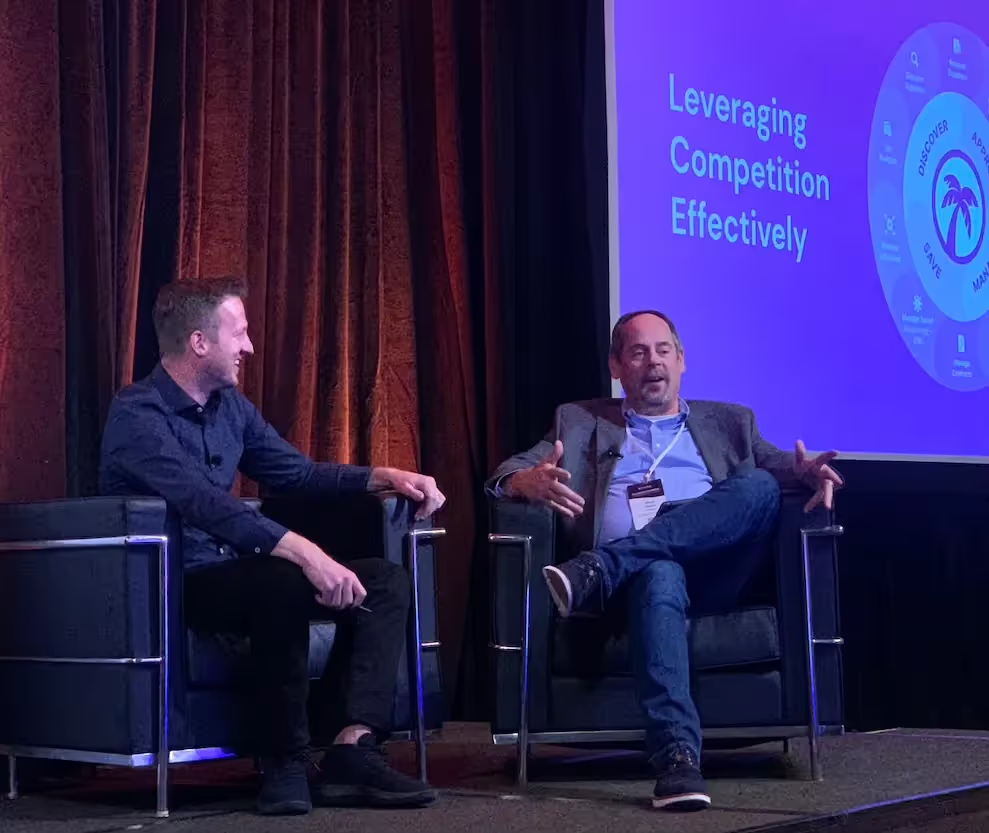Negotiations are always tricky. They’re even more delicate in an unsteady economy where companies have to do more with less.
With immense pressure to boost bottom-line efficiency, how can procurement teams become heroes inside their companies?
Hint: It starts at the negotiating table.
No two individuals know this better than Michael Shields, Head of Procurement Strategy at Tropic, and Brad Veech, Former Director of IT Sourcing at Walmart and author of Software: The Silent Killer of your Company’s Budget.
Shields and Veech recently teamed up for a fireside chat at this year’s FORGE: Technology Sourcing event in Chicago to discuss everything you need to know about a successful procurement negotiation.

Here are five takeaways from their conversation:
1. Be proactive about upcoming contract renewals
Steer your negotiation in the right direction by engaging early with internal stakeholders and suppliers, 6-12 months before the renewal date arrives.
“Know the notification (renewal) period, and get all information before that notification period hits. That is the key. You have more leverage at that point than you ever will in a renewal or similar situation like that,” explains Veech.
Integrating yourself early with internal stakeholders gives you greater flexibility (and more levers to pull) to align the necessary puzzle pieces for a successful negotiation.
Engaging early with suppliers also lets you play offense, giving you the ability to stand firm, rather than playing defense with little to no leverage.
Remember, you’re in a buyer’s market where budgets are tight and suppliers are hungry for revenue.
“From a supplier’s perspective, customer churn is huge right now,” Shields mentions.
.avif)
Use that position to your advantage so procurement can help drive costs down.
2. Anchor low
Start on the low end in your negotiations. This lets you gauge the flexibility of a supplier’s pricing structure.
Shields says kicking things off by anchoring low in a supplier’s price range means he has negotiated discounts anywhere from 8 to 80%.
Veech doubles down: “I don't know if you can anchor too low…I have no problem coming in low because their (suppliers’) long-term goal is to get in the door, get sticky, and then start increasing the prices.”
Remember, you’re in it to find the best tool at the best price for your specific needs.
Don’t be afraid to be candid about your budget (how many dollars are available for X tool) and timing (when the budget cycle is locked in) to cement your position at the negotiation table.
3. Battle back against all those small uplifts
It’s time to disrupt the domino effect of supplier uplifts—all those annual cost increases that software providers try to push through in their renewal negotiations. While Veech typically sees software companies propose massive 15-25% cost increases, both he and Shields suggest you battle tooth and nail against any uplift—whether it’s 2% or 25%.
Without a collective pushback from buyers during contract negotiations, uplifts remain easier to justify. Mainly because organizations continue accepting costly increases by signing on the dotted line without further digging.
.avif)
From Veech: “When they start getting those uplifts from people, and not getting the pushback, it becomes a snowball.”
The result? An unfortunate compounding effect where buyers pay more, time and time again. As Veech says, “They just keep asking and asking and asking (to increase prices).”
4. Customize your stakeholder approach
Lean into the specific personalities of internal stakeholders by understanding their likes, dislikes, and communication styles.
Procurement professionals aren’t always the most popular people inside a company. When department heads see them coming, they sometimes envision a long, drawn-out procurement process and many layers of red tape.
This can make it difficult for procurement teams to get buy-in from internal teams. Yet a negotiation cannot be successful without the support of internal stakeholders.
It becomes even more difficult when you do not understand each and every personality. As Veech says, “Everyone cooks at different temperatures.”
Develop trust and make it easier to win over internal parties by building genuine relationships. The byproduct: you have allies and more information to help power your negotiations.
Positive relationships with stakeholders may look like what Shields suggests, where stakeholders use their procurement teams as a buffer, sifting all supplier questions through procurement. “How empowering is that to you?” Shields asked. Veech’s response: “Yeah, that’s utopia.”
5. Think like a salesperson
Put yourself in a sales mindset by focusing on the customer—in this case, suppliers. In the classic sales playbook, you build trust and credibility with prospective customers to encourage them to buy your product. The same is true in procurement.
Whether it’s learning from an external sales group, your own internal sales team, or sales courses and events, Veech and Shields recommend that procurement professionals immerse themselves in sales training.
Shields often asks internal sales leaders for strategy overviews, with specific queries like:
- What questions are you asking?
- What are the key things that you're pushing?
- Which strategies are you employing so that my team can take that and internalize it?
Doing so helps procurement teams understand the layers of influence and strategy they may have as they go back and forth with suppliers.
In other words, as Veech explains, “It's understanding the levers that you have and when you can pull them at the right time.”
.avif)
Need more tips to negotiate smarter? Learn more from Michael Shields here.
Related blogs
Discover why hundreds of companies choose Tropic to gain visibility and control of their spend.







